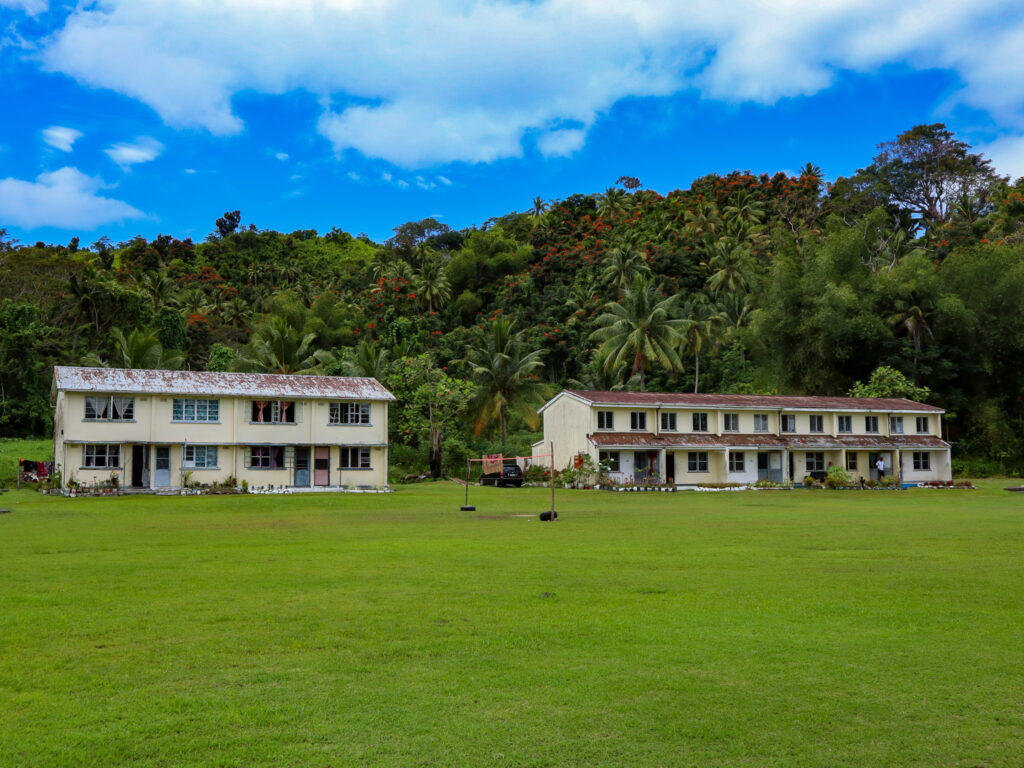After a week in Wallis and Futuna, we set off on our final overnight passage to our last destination for the year: Fiji! The first 24 hours of the trip were pretty standard, experiencing 15-20 knots, and the swell wasn’t too uncomfortable. Eitan relieved me from my watch at 6 am and I fell into a deep sleep, then woke abruptly feeling something was missing… the swell! We weren’t rolling at all anymore! I looked out at Eitan, sitting in the cockpit with a big smile on his face, we were behind the protection of Fiji’s outer reef. Our open-ocean sailing for the year was behind us! We (Eitan) no longer needed to plan passages, stress about weather windows, or worry about swell forecasts.
As the day went on the wind dropped down to an easy 10-15 knots and we glided along the surface of the water, slightly heeled over as the wind gently pushed us along to our destination. Sailing the rest of the day was a total dream and reminded me how it felt to actually enjoy sailing. No rolling, just feeling the power of the wind in the sails. We arrived at our anchorage just as the sun set, went for a quick swim, then popped a bottle of champagne to celebrate our arrival in Fiji. Eitan and I spend the evening talking about our highs, lows, and other memorable moments of the past 15,000 nautical miles together.
The next day we finished the remainder of the trip to Savusavu and began the entry process. Like before, we were boarded by several different officials and were finally checked in by 4:30pm, with just enough time to grab some SIM cards and reconnect to the world. We arrived at the cell phone kiosk, looked through the different data bundles, and couldn’t believe our eyes when we saw we could get 145 GB of data for just $10! This was by far the cheapest data we had seen and causing us to spend the rest of the evening mindlessly scrolling through social media as we filled our stomachs with cheap Indian food from a restaurant called Mum’s Country Kitchen.
As we walked around Savusavu, I couldn’t help but notice the racial diversity that existed here compared to the other countries we had visited in the South Pacific. Thus far, most of the local islanders resembled the characters from Moana with tan skin, brown wavy hair, and stout robust bodies decorated with tribal tattoos. Here in Fiji, the locals appeared to have more African and Indian ancestry, which isn’t too unusual for Commonwealth colonies with histories of slavery. Thanks to the Commonwealth, everyone speaks English, but Fijian and Hindi are still the most common.
We spent a few nights moored in Savusavu, catching up with friends over drinks at a marina restaurant called The Captain’s Table and saw a few local sights that were within walking distance. Normally, I would consider renting a car but the island of Vanua Levu is much larger than any of the islands we had been to and I struggled to find anything worthwhile to visit within a days drive that didn’t require a guide. Instead, we checked out a botanical garden, which had over 250 species of palm trees, followed by a trip to the local hot springs. I’m sure you can imagine that soaking in hot water is the last thing anyone would want to do in such a warm and humid environment. Instead, the hot water that boils out of the ground is used to cook food! Some of our friends used it to boil eggs and cook ramen.
In preparation for exploring some of the smaller islands, I perused the grocery stores and open-air market to stock up on provisions while Eitan went on the hunt for kava. Kava is a type of root used to make a sedative-type drink and is the national drink of Fiji. In order for us to visit any of the neighboring islands, it’s required for each boat to give a bundle of kava root as an offering (called sevusevu, which is confusingly similar to the name of the town) to the local village chief. Eitan purchased about six bundles at $10 per bundle, which made the inside of the boat smell horribly earthy and caused me to vacuum seal them right away.
Kava is common amongst the Pacific Islands and I had heard it is used to treat anxiety and insomnia, which sounded like a magic drug to me! I wasn’t able to find any information on preparing it from the root form, which was surprising since it was seemingly sold everywhere. Instead, I was able to purchase kava in a powdered form and was given a mesh bag to use as a strainer. Unlike loose leaf tea, you prepare the drink by massaging the contents of the bag in room temperature water, then squeeze it out and repeat for about 10 minutes. What was left in my cup resembled a mudpuddle which tasted about as good as it looked. After a few moments, the inside of my mouth tingled, but I didn’t seem to experience any of the other effects or benefits I had read about. I’ve heard the local concoctions are much stronger, though.
After a few days of being in the city, we were ready to start our last month of cruising for the season!



















